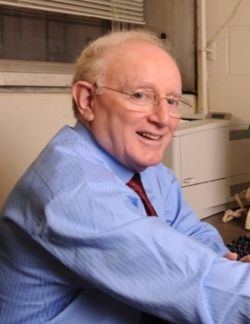
Department
School
Expertise
Teaching Interest
Biotechnology
Molecular Biology
Research Interests
Our laboratory focuses on two areas. The first is an investigation of factors secreted by certain pathogenic bacteria that can inhibit pathogen growth. These factors appear distinct from quorum sensors, which do not inhibit growth but switch on the expression of virulence genes when pathogens enter the stationary phase of growth in culture. Quorum sensors for Gram negative bacteria are derivatives of homoserine lactones, whereas quorum sensors for Gram positive bacteria are small peptides. Furthermore, these unknown factors also appear to be different from bacteriocins, which bacteria secrete and which prevent growth of competing organisms but not the bacterial species that secreted the factor. Our investigations center on the exact chemical structure for the inhibitory factors from both Gram negative and Gram positive organisms. Once the structures are known, we will investigate what regulates expression of these factors during growth, and how these factors might be used to treat patients with serious infections who are not responding well to antibiotics.
The second area of interest is the application of a novel and highly sensitive biosensor that uses molecular interactions to identify pathogens and/or biological materials. This patented biosensor was developed in collaboration with faculty at the University of Maryland, College Park. The biosensor combines biotechnological principles with a fiber optic-based operating system that employs a near-infrared laser to create a positive fluorescent signal. After passage through a photoelectric tube that converts light impulses into electric ones, the pulses are then amplified by many magnitudes-of order. The electric signals are then detected and displayed on an oscilloscope. Current applications of this system include uses in medicine, agriculture, and biological warfare.
Publications
Yang, L., Portugal, F. and Bentley, W.C. Conditioned medium from Listeria innocua stimulates emergence from a resting state:Not a response to quorum sensing autoinducer AI-2. Biotechnol. Prog. 22:387-393, 2006.
Pilevar S., Portugal, F., and Davis, C. Tapered optical fiber sensor using near-infrared fluorophores to assay hybridization. Anal. Chem. 70:2031-2037, 1998.
Twardzik, D., Pappas, T., and Portugal, F.H. DNA polymerase in virion of a reptilian type C virus. J. Virol. 13:166-170, 1974.
Twardzik, D., Simonds, J. and Portugal, F.H. Translation of AKR-murine leukemia viral RNA in an E. coli cell-free system. Biochem. Biophys. Res. Comm. 52:1108-1114, 1973.
Portugal, F.H., Simonds, J., Twardzik, D., and Oskarsson, M. Effects of simian virus 40- induced transformation on isoaccepting species of transfer RNA from mouse fibroblasts. J. Virol. 12:1616-1619, 1973.
Portugal, F.H., Simonds, J., Twardzik, D., Mulroy, P., and Oskarsson, M. Comparison of DNA-binding proteins from mouse cells in culture. Biochem. Biophys. Acta 51:789-796, 1973.
Portugal, F.H. Specificity of lysine and tyrosine transfer RNA fractions for RNA codons. Mech. Ageing and Develop. 1:23-32, 1972.
Portugal, F.H. Elution profiles of lysine and tyrosine transfer RNA during avian development. Mech. Ageing and Develop. 1:3-21, 1972.
Munro, H.N. and Portugal, F.H. Amino Acid Pools, In Bigwood, E.J. (Ed.), Encyclopedia of Nutrition, Pergamon Press, New York, pp. 197-213, 1972.
Hatfield, D., Portugal, F.H., and Caicuts, M. Transfer RNA specificity in mammalian tissues and codon responses of seryl transfer RNA. Cancer Res. 31:697-700, 1971.
Portugal, F.H., Ellwyn, D., and Jeffay, H. Lysine compartments in rat liver cells. Biochim. Biophys. Acta 215:339-347, 1970.
Hatfield, D. and Portugal, F.H. Seryl-tRNA in mammalian tissues: Chromatographic differences in brain and liver and a specific response to the codon UGA. Proc. Natl. Acad. Sciences U.S.A. 67:1200-1206, 1970.
